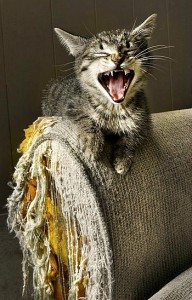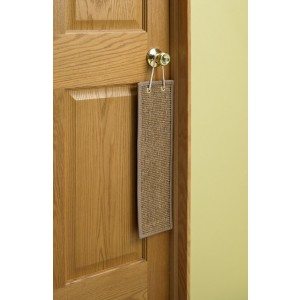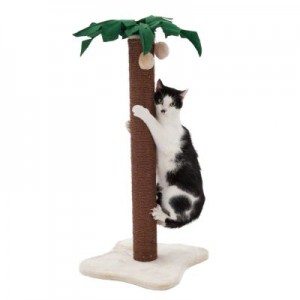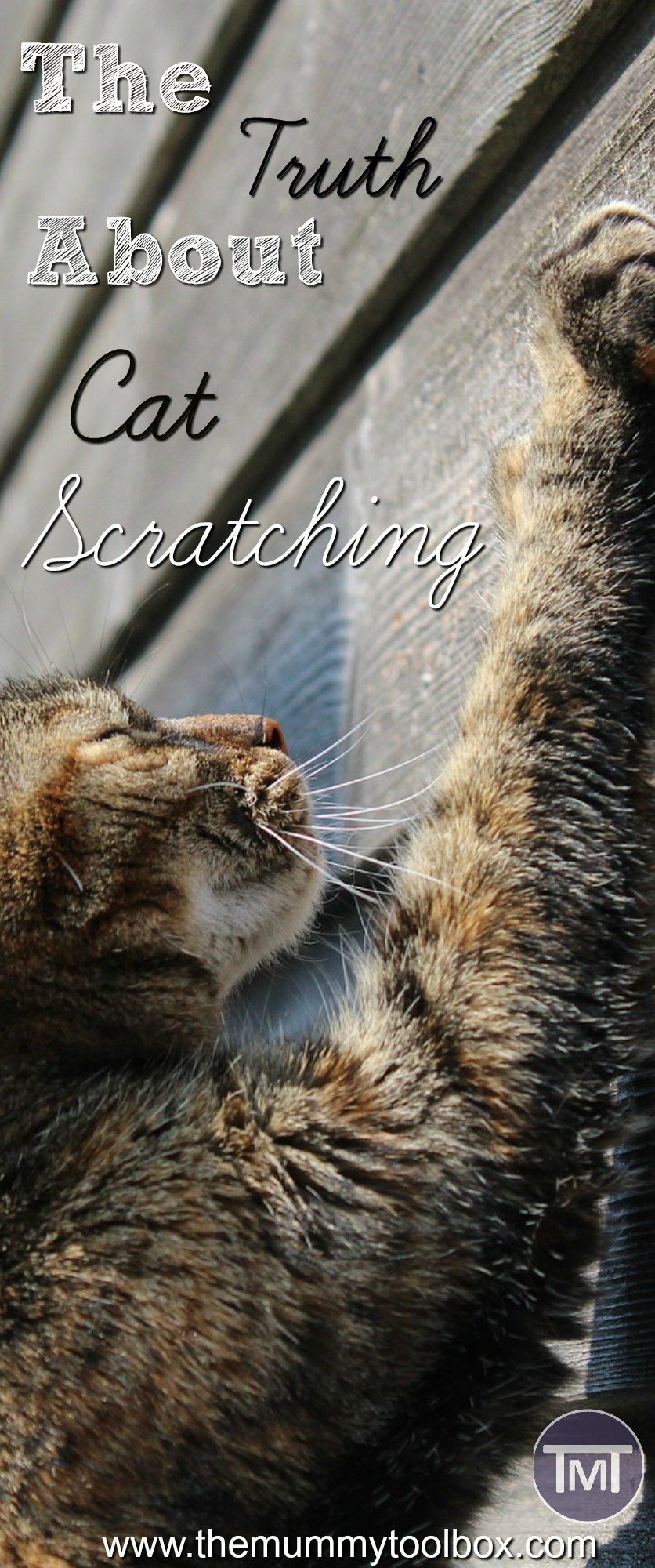This post may contain affiliate links, or we may earn money from the companies mentioned in this post. For more information on this, please visit our legal page.
Let’s discuss some cat behaviour, more specifically cat scratching!
Scratching is natural for cats, but it can cause a problem for your £1000 (or more) sofa. Here is everything you need to know about why cats scratch, different types of scratchers, how to accommodate this and making your own posts for a frugal alternative. Cats can use scratching to help with claw maintenance but you can help them too! Here are some extra cat claw care tips to help your scratcher stay healthy.
Why do cats scratch?
Cats like to scratch! aside from the fact they enjoy it, it is also good for them and part of their natural behaviour. Here are just a few reasons for cat scratching:
- Scent marking – They have glands in their paws to mark their territory
- Manicure – All right, not quite. Scratching removes the dead outer layer (husk) on their claws, so scratching is like sharpening them (sort of)
- Yoga Help – You’ll notice that when a cat scratches it also stretches at the same time. Digging their claws in can help them get more of a stretch (obviously relieving all of that stress they are feeling from sleeping all day – hard life)
- Attention seeking – Ever noticed how sometimes they only scratch when you walk in the room, on the chair or carpet you expressly forbid them too! looks like they are trying to get your attention, maybe it’s dinner time or they are in need of a cuddle!
*Note: Excessive scratching around the home can be signs of an unhappy/insecure cat. If you feel your cat is abnormally scratching try contacting your vet for advice*
Not on the furniture!?
“Not the new sofa/chair/carpet/bag/hallway (I could go on) !!!” This happens a lot and a cat does NOT care about any of your stuff, they are just looking for a place to get their scratch on. Take note of the type of furniture the cat is scratching on and it can give you an idea of the type of scratcher that your cat is (see the different types of scratcher below).

To discourage scratching on the furniture you can:
Offer appropriate alternatives: There is no point in trying to stop them from scratching (it’s natural for them) instead offer them somewhere else (see pleasing the scratcher below). Make sure the options have enough resistance and are big enough for your cat.
Remove or cover previous scratches – If you can, cover any fabric scratches, sand down any wood scratches and try to cover anything else that’s left. This discourages them from coming back and making individual items or areas a regular scratching ground.
Sticky tape – I have used this one or twice for persistent sofa scratching. Use double sided tape (or loop normal tape around) and place on the area you are discouraging from. Make sure it is not too sticky (it could harm their paws) and check the type of adhesive first to make sure it won’t irritate them but they DO NOT like getting stuck to the sofa (mine sulked for days).
Deterrents – Chemicals such as “Feliway” that comes as a spray or room diffuser uses pheromones to reduce stress and anxiety and discourage scratching in that area.
Find out why – Persistent scratching can be a sign that your cat is nervous or unhappy or in some cases want something. Try to find out what they need and if necessary contact your vet who might be able to offer advice to solve the underlining issue.
Types of scratcher

Horizontal – These kitties choose to scratch downwards (carpets, mats, expensive bags you accidentally leave on the floor etc)

Vertical – These are cats who generally prefer to scratch upwards (trees, posts, bannisters, side of the sofa etc).
Combo– I am a part of this lucky category because my cats (Meet them here) are all a combination scratcher type and will scratch however they can.
How to please each type of scratcher

Horizontal Scratching
To please these scratchers look into:
Mats – These are placed on the floor (exactly as they sound). My cats really enjoy scratching on bathroom or doormats! so I buy £1.20 mats from Ikea (see here.) for them to scratch as much as they like (and they are cheap and cheerful). I place these by the doors because we don’t have a cat flap and my cats scratch when they want to go out. Also, they end up wiping their paws (not intentionally- haha could you imagine) on the way back in.
Boxes – These are a nifty find (I’m taking all the credit) and my cats love them! they are made from cardboard and because they are a completely different material (usually scented with catnip) you can move them around the house (once they have gotten used to them). Also as they are cardboard they are less expensive (£7 from Pets at home).

Carpet pieces – Get an old piece of carpet (the size of a doormat- or just over the length of your cat) and place it so that the cat can easily access it to scratch. The downside to this is that it can be hard for them to differentiate between “old scratching piece of carpet” and “brand new, don’t touch carpet”, try catnip or treats to encourage them to use this piece of carpet only. You can also try placing it on the kitchen floor/hard flooring so they can notice the difference. The key to these is to find a spot and stick to it.
Vertical Scratching
To accommodate these scratchers look into:
Hanging mats – (Exactly as they sound) these can be a great way to cover up any current scratches too!

Posts: This is the one we all know about. They can be part of a larger complex or just on their own.


*REMEMBER: Posts should be taller than your cat (on its hind legs). Vertical scratchers usually stretch this way too so they won’t get a full reach (or stretch) if it is too short (making it an interesting -but useless- feature of your room)*
Both: Although any of the above can accommodate these scratchers, here are some other alternative options to keep them happy too;
Inclined scratchers or Arches – not quite up, not quite down.

Covered mats/boxes: Shy or nervous cats could benefit from a covered mat or box to make them feel safe.

Encouraging Kitties to Use Them
So, you’ve got a really fancy scratching post ! and your cat has sniffed it and walked away (been there). Cats can be resistant to change. You can encourage use of the scratching post by;
Appropriate Placement – which area does your cat like to scratch? do they feel comfortable scratching here? do they usually scratch here? are the old scratches covered? these are the kind of questions you should ask to find out if it’s the right place.
Strictly for scratching – I know this sounds strange but don’t put your own things on the scratchers (leaving shoes,bags, clothes etc) because it confuses them as to who’s scratcher it is.
Catnip – If your kitty is a little druggy (like mine :p) then you can sprinkle some catnip on the scratcher to encourage them to go there.
Treats – Place kitty treats on the post (and on high levels if you have them) to encourage them to jump up and be around the post at first to acclimate.
Keep it Static – Don’t keep moving it around. At first let them get used to the post/scratcher, only move it if they are refusing to go near it at all (it could be an environmental thing). If they start to scratch or explore it then leave it where it is. Some cats won’t like it being moved and others will get over it so find out what is best for them.
Play hunting games – Play with them, with string or mice (or whichever hunting games you use) to encourage them to dig their claws into the material. A lot of cats will come back and re-use it once they have tried it once.
Make your own
If you are the crafty kind there are lots of options for making your own Cat Scratcher, my fav’s are:
- Cardboard Cat Scratcher by Instructables
- How to Make a Cat Scratching Post by Wiki How
- Natural Tree Scratching Post by Purina One
- How to Make a Scratching Post for Cats by Martha Stewart
What is Declawing?
Declawing is the act of removing cat claws surgically (this also includes the extension of the toe bones – because of the anatomy of the toes). Although technically it can stop a cat scratching it can be painful and affect many other aspects of the cat’s life including its ability to hunt and defend itself which are all its natural behaviours. I (and a lot of vets) feel it is morally wrong and there is no benefit from it. Declawing is illegal in the UK (except on medical grounds) and I almost wasn’t going to add this because I personally disagree with the whole thing (unless medically necessary etc) BUT since a lot of my readers come from countries that it is still legal/common I thought I would add it in.
Do you have a scratcher in the house? how do you deter them? let me know in the comments below.
*This post is a part of #CatWeek 2015*
You may also be interested in these Pinterest boards:
15 comments on “The Truth About Cat Scratching”
Comments are closed.

Luckily I have never had a cat who scratches badly indoors. Henry will very occasionally try to scratch the sofa but a sharp no and he stops … he is getting old and does not like going outside but we regularly put him out so he can have a decent scratch on something more suitable outside. Thanks you for adding this very informative post to #AnimalTales
Thanks for some useful tips. Our rescue kitty is a terrible scratcher and I am always looking for help with it.
We had a cat visit for christmas called Molly and she was scratching up our sofa big time and I was getting a bit frustrated. These are really useful ideas and gave me more understanding. Thanks
Some great tips for helping keep your house pristine from cat scratches! #animaltales
I haven’t owned a cat for a while (and we are about to get our first puppy, so where once I was a cat-person, looks like I am going to soon be a dog person, yikes!)but I wish these scratching complexes had been around when I had..
I had no idea there was so much to cats’ scratching. I love all the different things you can get to help them do it in a amore constructive (to humans) way 🙂 #AnimalTales
My brother just sent me a photo of his “scratched arm”. His cat did it because she didn’t want to be petted! 😉 #animaltales
I never knew why cats scratched, this is a great article explained how and why. I don’t have cats but tons of my friends do, I’m going to share this, especially since it will help the cats and their owners! Pinning too!
Thanks so much i’m glad you found it useful 🙂 x
Hi Charlotte, I’m new to the world of cats, but have noticed our not-so-feral-anymore out door cats scratching and stretching. They seem to favour the logs on the woodpile and the doormat; one of them liked shoes, but we put a stop to that.
It must be quite tricky having an indoor cat that won’t scratch where you’d like them too.
xx
My crazy little girl likes both types of scratching. We have a three tiered post for her to scratch, climb and sleep on.
However I now need to own that castle scratch complex, and will not be happy again till I do 😉
Thanks for linking up, Tracey xx
#abitofeverything
haha I saw that castle and just thought – I need it! – whether they want it or not :p X
Our Bil loves hunting games and use his scratcher a lot. He still acts like a kitten, which is surprising considering he’s 15 next April! 🙂
Coming from WAYWOW. Love your blog!
xx
Mila